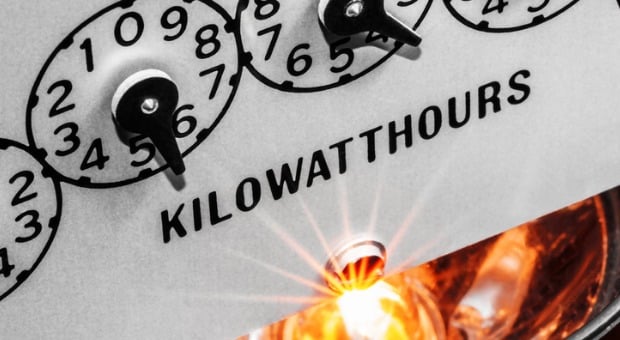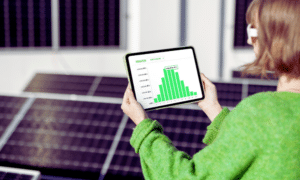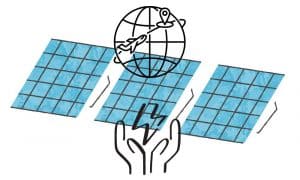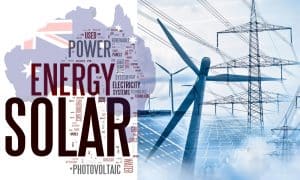On this page
The difference between kW and kWh can be complicated and not usually something that is commonly known by the average household in Australia. Many energy experts still wrestle with the differences between the two.
But understanding these terms will give you tremendous insight into correctly reading your electricity bills and overall energy consumption.
It will give you the tools to manage your future consumption better and slash hundreds of dollars of your annual bills in the process.
Energy Matters has been a leader in the renewable energy industry since 2005 and has helped over 40,000 Australian households in their journey to energy independence.
Let us discuss and choose the best quote that suits your needs and budget, and we can connect you with our trusted local solar installers in Melbourne, who will provide up to 3 FREE quotes for your home and business solar energy system. Get your free quotes today!
What Are kW and kWh? Explaining the Basics
Imagine you’re in charge of a bustling kitchen, cooking up a storm with various appliances. Now, let’s dive into the world of energy lingo and meet our two main characters: kW and kWh.
Think of kW as the chef’s speedometer, measuring how fast energy is being used or generated at a specific moment. Just like a car’s speedometer tells you how fast you’re driving, kW tells you how fast energy is flowing. So, when you turn on your toaster, it might use 1 kW of power to toast your bread quickly.
Now, let’s talk about kWh. Imagine you’re hosting a dinner party, and you need to know how much food you’ve consumed at the end of the night. kWh is like the total amount of food you’ve eaten over time – it’s a measure of energy consumption or production over a period.
Here’s the breakdown:
- Kilowatt (kW): The rate of energy usage at a given moment, like how fast you’re eating at the dinner table.
- Kilowatt-Hour (kWh): The total amount of energy consumed or produced over time, similar to how much food you’ve eaten throughout the dinner party.
So, if your oven runs at 1 kW for an hour, it consumes 1 kWh of energy. It’s like eating one big meal – you’ve consumed a certain amount of energy over that time.
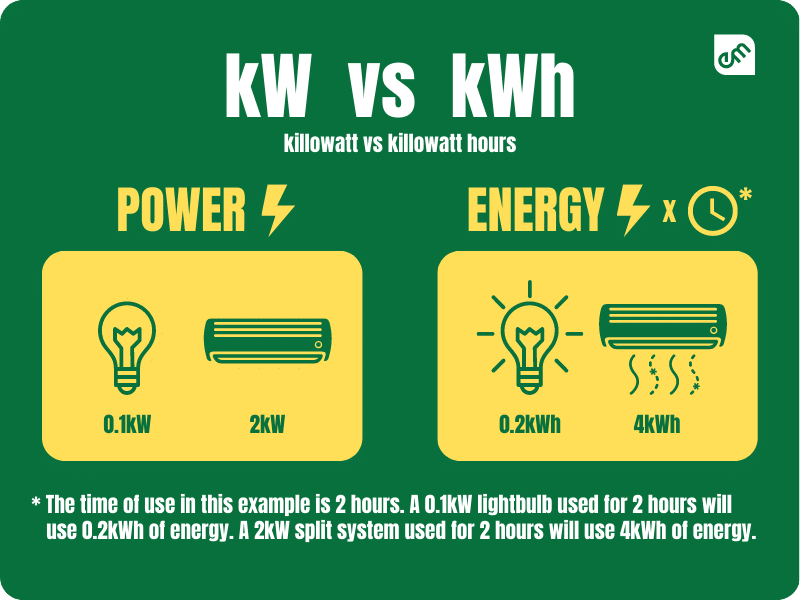
Kilowatt (kW) is a unit of power, measuring how quickly energy is being used or generated at a specific moment. It’s like the horsepower of the energy world, indicating the rate at which work is being done.
Here’s a clearer breakdown:
- Kilowatt (kW): The rate of energy usage or generation at a specific instant.
Now, let’s put kW into perspective with some common household appliances and their average power ratings:
- Toaster: A toaster typically uses around 0.7 to 1.5 kW when toasting your bread to golden perfection. So, if your toaster operates at 1 kW, it means it’s using 1 kilowatt of power at that moment.
- Microwave Oven: A microwave oven might consume around 0.6 to 1.5 kW while heating your leftovers. If it’s rated at 1.2 kW, that’s the power it’s using during operation.
- Hairdryer: Ever wondered how much power your hairdryer gobbles up? It’s usually around 1 to 2 kW. So, if your hairdryer is rated at 1.5 kW, that’s the power it’s drawing to dry your hair efficiently.
- Refrigerator: Your trusty refrigerator might consume around 100 to 800 watts (0.1 to 0.8 kW) to keep your food cool. If it operates at 0.5 kW, that’s the power it’s using to maintain its chill factor.
Defining kWh (Kilowatt-Hour): Measuring Energy Consumption
Kilowatt-hour (kWh) is a unit of energy consumption over time, indicating the total amount of energy used or generated within an hour. It’s like measuring how much fuel your car consumes on a trip – it tells you the total energy expenditure over a specific period.
Here is an example:
Imagine you have an appliance that runs at 1 kilowatt (kW) of power. If you run this appliance continuously for one hour, you’ll have used 1 kilowatt-hour (kWh) of energy.
Here’s how it works:
- 1 kW Appliance Running for 1 Hour = 1 kWh of Energy Used
Now, let’s consider a few scenarios:
- Toaster Scenario: Your toaster operates at 1 kW. If you use it for one hour straight to toast bread for breakfast, you’ve consumed 1 kWh of energy.
- Microwave Scenario: Suppose your microwave oven is rated at 1.2 kW. If you heat leftovers for 45 minutes, you’ve consumed 0.9 kWh of energy (1.2 kW * 0.75 hours = 0.9 kWh).
- Hairdryer Scenario: Your hairdryer operates at 1.5 kW. If you use it for 20 minutes, you’ve consumed 0.5 kWh of energy (1.5 kW * 0.333 hours = 0.5 kWh).
In each scenario, the kWh measurement tells you how much energy you’ve used over the given time period. It’s like tracking how many miles you’ve driven on a trip – the kWh indicates your total energy consumption.
The Difference Between kW and kWh and Why It Matters
Understanding the difference between kW (kilowatts) and kWh (kilowatt-hours) is crucial because it affects various aspects of our lives, from energy billing to system sizing for generators or solar panels. Let’s delve into why this distinction matters with some practical examples:
Energy Billing:
When you receive your electricity bill, you’re often charged based on the amount of energy you’ve consumed, measured in kilowatt-hours (kWh), not the power you’ve used at any given moment (kW). This is because kWh reflects the total energy usage over time, whereas kW indicates the rate of energy consumption at a specific instant.
For instance, let’s say you have two households, both with the same monthly energy consumption of 500 kWh. However, one household consistently runs high-power appliances like air conditioners and electric heaters, resulting in higher kW demand peaks during the day. The other household uses energy more evenly throughout the day with lower-power appliances. Despite having the same total energy consumption, the first household might face higher electricity bills due to its higher kW demand, reflecting the importance of understanding both kW and kWh in energy billing.
System Sizing for Generators or Solar Panels:
When sizing energy systems like generators or solar panels, understanding kW and kWh helps ensure they meet your power and energy needs efficiently.
For example, let’s consider a business that needs backup power during outages. If they have essential equipment totaling 10 kW in power requirements and anticipate needing this backup power for four hours, they would need a generator capable of providing 40 kWh of energy (10 kW * 4 hours = 40 kWh). Understanding the distinction between kW and kWh ensures the generator is appropriately sized to meet their energy needs over the desired period.
Similarly, when installing solar panels, the kW rating of the system indicates its maximum power output under ideal conditions, while the kWh generated over time determines its energy production capacity.
By considering both factors, homeowners and businesses can size their solar installations to match their energy consumption patterns accurately, optimizing energy production and cost savings.
Calculating kW and kWh: A Step-by-Step Guide
Calculating the power (kW) and energy consumption (kWh) of household appliances is straightforward once you understand the basic principles. Here’s a simple tutorial to guide you through the process:
Step 1: Determine the Power Rating (kW) of the Appliance
The power rating of an appliance is typically listed on its label or in the user manual. It’s measured in kilowatts (kW) and indicates the rate at which the appliance consumes energy when operating.
Step 2: Determine the Operating Time
Next, determine how long the appliance will be running. This could be in hours, minutes, or even seconds, depending on your calculation needs.
Step 3: Calculate Power (kW)
To calculate the power (kW) of an appliance, use the formula:
Power (kW)=Power Rating (Watts) 1000
Power (kW)=1000 Power Rating (Watts)
If the power rating is already in kilowatts, you can skip this step.
Step 4: Calculate Energy Consumption (kWh)
To calculate the energy consumption (kWh) of an appliance, use the formula:
Energy Consumption (kWh) = Power (kW) × Operating Time (hours) Energy Consumption (kWh)=Power (kW)×Operating Time (hours)
The Role of kW and kWh in Energy Efficiency
Understanding and monitoring kilowatts (kW) and kilowatt-hours (kWh) play a crucial role in promoting energy efficiency. By grasping these concepts, individuals can make informed decisions that lead to reduced energy consumption, lower utility bills, and a smaller environmental footprint. Let’s explore how kW and kWh contribute to energy efficiency and discuss strategies for reducing kWh usage in homes:
Strategies for Reducing kWh Usage:
- Energy-Efficient Appliances: Invest in ENERGY STAR-rated appliances, which are designed to consume less energy without sacrificing performance. These appliances often have lower kW ratings and use innovative technologies to minimize kWh usage.
- Behavior Changes: Adopt energy-saving habits such as turning off lights and unplugging electronics when not in use, using power strips to easily switch off multiple devices, and optimizing appliance settings for efficiency (e.g., using cold water for laundry).
- Home Improvements: Consider implementing home improvements to enhance energy efficiency, such as adding insulation to reduce heating and cooling demands, sealing air leaks to prevent energy loss, upgrading to energy-efficient windows and doors, and installing programmable thermostats for better temperature control.
- Renewable Energy Integration: Explore renewable energy options like solar panels or wind turbines to generate clean electricity on-site. By harnessing renewable energy sources, homeowners can reduce their reliance on grid-supplied electricity and lower their overall kWh usage.
- Smart Home Technology: Embrace smart home technology, including smart thermostats, lighting systems, and appliances that can be controlled remotely or programmed to operate more efficiently. These devices help optimize energy usage by adjusting settings based on occupancy, time of day, and energy demand.
Identifying High Energy-Consuming Appliances
By learning the power requirements of your appliances in watts and kW, you can understand how much they will impact your electricity bill and adjust your usage accordingly.
These figures are meant as a guide only (as different appliances from different manufacturers vary), but this is the average power consumption of essential household appliances:
- Blender: 500 watts
- Toaster: 850 watts
- Microwave: 1 kW
- Vacuum: 1 kW
- Dishwasher: 1.5 kW
- Hairdryer: 1.5 kW
- Clothes dryer: 3 kW
- Wall air conditioner: 3.25 kW
- Central air conditioner: 3.8 kW
- Electric water heater: 4.5 kW
- Electric water heater (tankless): 18 kW
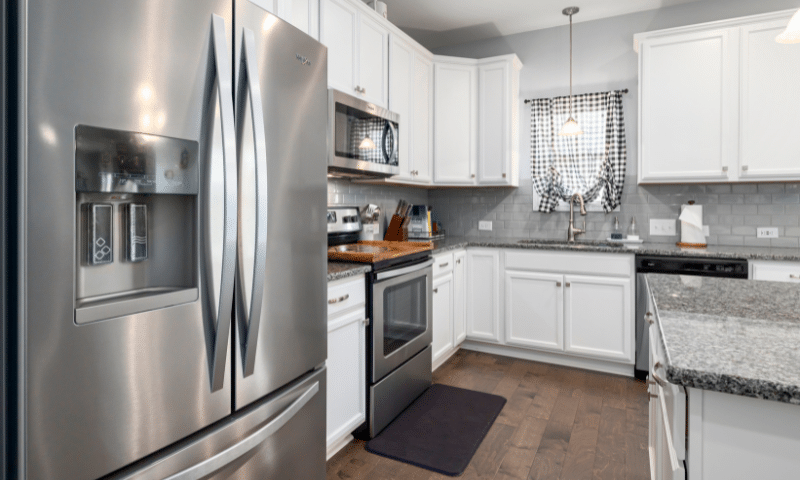
Other appliances, like fridges and freezers, will have alternating wattage requirements as they only operate at maximum capacity at specific day points. It is the same with computers and televisions when they go into “sleep mode”. While they will require less kWh to run, they will still take up a considerable consumption rate.
This list shows that small appliances like the average vacuum and hairdryer require a lot of power to operate. It also indicates that luxuries like tankless water heating options can be costly, giving tips on saving your electricity bill.
How Understanding kW and kWh Can Lower Your Electricity Bill
- Demand Charges: Many utility companies apply demand charges based on the highest rate of energy consumption (kW) within a specific period, typically measured in 15-minute intervals. By understanding your peak demand and taking steps to reduce it, such as staggering the use of high-power appliances or investing in energy management systems, you can avoid costly demand charges.
- Tiered Pricing: Some utility tariffs feature tiered pricing, where the rate per kWh increases as consumption levels rise. By monitoring and managing your kWh usage, particularly during peak times when rates may be higher, you can stay within lower-priced tiers and minimize your overall electricity costs.
- Time-of-Use (TOU) Rates: TOU rates vary based on the time of day, with higher rates during peak hours and lower rates during off-peak periods. By shifting energy-intensive activities, such as running appliances or charging electric vehicles, to off-peak hours, consumers can take advantage of lower rates and reduce their kWh usage when electricity is most expensive.
kW and kWh in the Context of Solar Energy
Understanding the relationship between kilowatts (kW) and kilowatt-hours (kWh) is essential when considering solar energy systems. Solar panel output is measured in kW, indicating the maximum power they can generate at any given moment, while energy production is measured in kWh, representing the total amount of energy generated over time. Let’s delve into how these concepts apply to solar energy and how to estimate the size of a solar power system based on kWh consumption:
1. Solar Panel Output (kW):
- Solar panels are rated based on their maximum power output under standard test conditions, typically expressed in kilowatts (kW).
- The kW rating indicates the peak power that the solar panels can produce when exposed to optimal sunlight conditions, such as direct sunlight at a certain angle.
- It’s important to note that solar panel output can vary based on factors like sunlight intensity, shading, and panel orientation.
2. Energy Production (kWh):
- Energy production from solar panels is measured in kilowatt-hours (kWh), representing the total amount of electricity generated over a specific period, such as a day, month, or year.
- The kWh production depends on factors like the size and efficiency of the solar panel system, sunlight availability, and geographical location.
3. Estimating Solar Power System Size:
- To estimate the size of a solar power system needed based on kWh consumption, start by assessing your average daily or monthly electricity usage in kWh. This information can typically be found on your utility bill.
- Calculate the daily or monthly kWh consumption and consider any potential changes in energy usage patterns or future growth.
- Next, determine the solar irradiance in your location, which indicates the average amount of sunlight available for solar energy generation. This information can be obtained from solar resource maps or online tools.
- Based on your energy consumption and solar irradiance, you can estimate the size of the solar power system required to meet your electricity needs. This is typically expressed in terms of the total kW capacity of the solar panels needed.
- It’s important to consider factors like panel efficiency, system orientation, shading, and available roof space when sizing the solar power system.
How Solar Panels Use kW and kWh
Many people know installing solar panels will reduce their energy bills but sometimes don’t understand why.
Solar systems are usually sold with a rating. For example, you might be looking to invest in a 5kW solar array for your home. That means 5kW is the maximum output this system can produce at any given time.
It will fluctuate depending on sunlight and other factors, so you cannot expect a constant flow of 5kW from your system.
You want to look at the kWh that your system is producing for your home. If a solar system consistently makes 1kW of power over an hour, you will get 1kWh of energy for your home.
You can refer to the previous list (and the ratings on your appliances themselves).
If you are getting 1kWh every hour of the day, you are getting enough power to run your microwave 24 hours a day (not that you would do that, nor do solar panels work at night!).
So when looking at a solar system, always focus on the kWh it produces rather than its kW rating to get a complete picture of how the system will benefit you.
Making the Most of Your Energy Usage: Tips for Efficiency
Here are practical tips for efficiency:
1. Quick Wins:
- Unplug Devices: Avoid phantom energy usage by unplugging electronics when not in use.
- LED Lighting: Switch to energy-efficient LED bulbs for longer-lasting, lower-energy lighting.
- Seal Air Leaks: Seal gaps around windows and doors to prevent energy loss.
2. Regular Maintenance:
- HVAC System: Keep your HVAC system well-maintained to ensure efficiency.
- Appliance Care: Clean coils and replace seals on appliances to optimize performance.
3. Energy-Efficient Appliances:
- Choose ENERGY STAR: Opt for ENERGY STAR-certified appliances for lower energy consumption.
- Smart Thermostats: Use programmable thermostats to regulate heating and cooling efficiently.
4. Smart Home Technologies:
- Smart Lighting: Install smart lighting systems with motion sensors for automated control.
- Energy Monitoring Devices: Use smart plugs to monitor and manage energy usage in real-time.
5. Longer-Term Investments:
- Solar Panels: Consider investing in solar panels for long-term energy savings and sustainability.
- Insulation and Windows: Improve insulation and upgrade to energy-efficient windows to reduce heating and cooling costs.
Evaluating Your Electricity Plan: Is It Time to Switch?
To assess whether switching your electricity plan is worthwhile, start by analyzing your kW and kWh usage to understand your energy needs accurately. Review past bills or utilize online tools provided by your utility company for insights.
Next, compare the rates and terms of your current plan with other available options, considering factors like fixed vs. variable rates, contract lengths, and additional fees. Additionally, explore renewable energy options offered by your utility or third-party suppliers, assessing the availability of green energy sources like solar or wind power.
Research customer reviews and satisfaction ratings to gauge provider reliability and customer service quality. Calculate potential savings using online calculators or provider estimates, factoring in incentives or rebates for switching to renewable energy options.
Ultimately, weigh the potential short-term savings and long-term sustainability goals to make an informed decision about switching electricity plans.
Become an energy efficiency saving expert
Can I cut back on my electricity usage? You can calculate what a single kWh is worth to see the energy used in your home.
Greater energy efficiency means that solar power will supply more of your electrical demands, lowering your power costs even further and maximising the benefits of feed-in tariffs, even if you are only partially powering your home with solar panels.
Switching to a better plan?
You may already have an energy plan but want to shop for a better deal.
Energy Matters’ “Energy Health Check” is a cutting-edge energy comparator tool that allows you to compare your area’s most competitive retail offers. We collect the data from our wide range of trusted retailers, allowing you to decide about changing your plan.
If your goal is to minimise the cost of your gas and electricity bills, switch to a better plan now!









